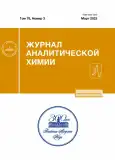Evaluation of a Possibility of the Application of “Electronic Nose” to Monitoring Deviations in the Functional Obesity of Children in Hospital Conditions: Observations of Changes during Treatment
- Autores: Kuchmenko T.A.1,2, Dorovskaya E.S.1, Menzhulina D.A.3, Chubarov T.V.3, Murakhovskii I.A.1
-
Afiliações:
- Voronezh State University of Engineering Technologies
- Vernadsky Institute of Geochemistry and Analytical Chemistry, Russian Academy of Sciences
- Burdenko Voronezh State Medical University
- Edição: Volume 78, Nº 3 (2023)
- Páginas: 274-287
- Seção: ORIGINAL ARTICLES
- ##submission.dateSubmitted##: 14.10.2023
- URL: https://journals.rcsi.science/0044-4502/article/view/136023
- DOI: https://doi.org/10.31857/S0044450223020056
- EDN: https://elibrary.ru/FVOJJN
- ID: 136023
Citar
Texto integral
Resumo
This work is a continuation of a study on the use of chemical gas sensors and a portable “electronic nose” for diagnosing obesity and related pathologies in children in a hospital. Using a portable Bio-8 device, 330 volatile skin compound profiles were measured in the forearm region on an empty stomach in various states of children with various diseases during inpatient examinations and treatment in the endocrinology department. Monitoring changes in the profile of volatile skin compounds during the period of hospital stay in obese children made it possible to identify priority metabolic disorders in multiple pathological disorders and diagnoses by a characteristic set of chemical biomerkers of processes, reliably detected in skin secretions on the right forearm. Multiparametric data of the “electronic nose” were processed by principal component analysis to assess ranking of the results into the groups “Normal” and “Obesity with a risk of the development of type 2 diabetes mellitus (DM)”. Based on the highly informative parameters of the sensor array, changes in the chemical composition of the skin gas profile on the right forearm during the period of patients’ stay in the hospital and the effectiveness of standard approaches in each specific case were evaluated, and the personalization of treatment was thus increased. Simple calculated parameters and a method for assessing lipid and carbohydrate metabolism disorders based on the signals of eight sensors above the skin measured for 200 s without sampling were proposed. The sensitivity of the method for monitoring changes in the metabolome in a hospital is at least 80%. Specificity for lipid metabolism disorders is 100%; for type 1 diabetes, 100%; and for mixed pathologies varies from 70 to 85%.
Palavras-chave
Sobre autores
T. Kuchmenko
Voronezh State University of Engineering Technologies;Vernadsky Institute of Geochemistry and Analytical Chemistry, Russian Academy of Sciences
Email: tak1907@mail.ru
394036, Voronezh, Russia; 119334, Moscow, Russia
E. Dorovskaya
Voronezh State University of Engineering Technologies
Email: tak1907@mail.ru
394036, Voronezh, Russia
D. Menzhulina
Burdenko Voronezh State Medical University
Email: tak1907@mail.ru
394000, Voronezh, Russia
T. Chubarov
Burdenko Voronezh State Medical University
Email: tak1907@mail.ru
394000, Voronezh, Russia
I. Murakhovskii
Voronezh State University of Engineering Technologies
Autor responsável pela correspondência
Email: tak1907@mail.ru
394036, Voronezh, Russia
Bibliografia
- Dietz W.H. Health consequences of obesity in youth: Childhood predictors of adult disease // Pediatrics. 1998. V. 101. P. 518.
- Elgar F.J. Validity of self-reported height and weight and predictors of bias in adolescents // J. Adolesc. Health. 2005. V. 37. p. 371.
- Подростковое ожирение и связанное с ним поведение: тенденции и социальные неравенства в Европейском регионе ВОЗ, 2002–2014 годы: наблюдения по итогам совместного межнационального исследования ВОЗ “Поведение детей школьного возраста в отношении здоровья” (HBSC). URL: https://apps.who.int/iris/handle/10665/329418 (дата обращения 14.02.2022).
- Литвицкий П.Ф. Патофизиология: Учебник: 2-е изд., испр. и доп. М.: ГЭОТАР-МЕД, 2003. Т. 1.
- Кучменко Т.А., Доровская Е.С., Менжулина Д.А., Чубаров Т.В. Оценка возможности применения “электронного носа” для мониторинга отклонений при функциональном ожирении детей в условиях стационара. Неинвазивная диагностика без отбора проб // Журн. аналит. химии. 2022. Т. 77. № 12. https://doi.org/10.31857/S0044450222120088
- Poncette Akira-Sebastian, Wunderlich M. M., Spies C., Heeren P., Vorderwülbecke G., Salgado E., Kastrup M., A Feufel M., Balzer F. Patient monitoring alarms in an intensive care unit: observational study with do-it-yourself instructions // J. Med. Internet Res. 2021. T. 23. V. 5. p. 26494. https://doi.org/10.2196/26494
- Weenk M., van Goor H., Frietman B., Engelen L.J., van Laarhoven C.J., Smit J., Bredie S.J., van de Belt T.H. Continuous monitoring of vital signs using wearable devices on the general ward: Pilot study // JMIR mHealth and uHealth. 2017. T. 5 V. 7. p. 91. 28679490' target='_blank'>https://doi.org/10.2196/mhealth.7208.PMID: 28679490
- Weenk M, Bredie S.J., Koeneman M., Hesselink G., van Goor H, van de Belt T.H. Continuous monitoring of vital signs in the general ward using wearable devices: Randomized controlled trial // J Med. Internet Res. 2020. T. 22. V. 6. p. 15471. 32519972;PMCID:' target='_blank'>https://doi.org/10.2196/15471PMID: 32519972;PMCID: PMC7315364
- Rossum M.C., Vlaskamp L.B., Posthuma L.M. Adaptive threshold-based alarm strategies for continuous vital signs monitoring // J. Clin. Monit. Comput. 2022. T. 36. V. 2. p. 407. https://doi.org/10.1007/s10877-021-00666-4
- Кучменко Т.А., Доровская Е.С., Менжулина Д.А., Умарханов Р.У. Мобильное устройство на основе массива сенсоров для анализа биопроб малого объема. Патент на изобретение 2764964 C1. Заявка № 2021110885 от 16.04.2021. Опубл. 24.01.2022.
- Кучменко Т.А., Доровская Е.С., Босикова Ю.Н., Сметанкина А.В., Битюкова В.В. Применение “электронного носа” на пьезосенсорах для сканирования летучих соединений гинекологических проб // Журн. аналит. химии. 2021. Т. 76. № 7. С. 634. (Kuchmenko T.A., Dorovskaya E.S., Bosikova Y.N., Smetankina A.V., Bityukova V.V. Application of an electronic nose based on piezoelectric sensors for scanning volatile compounds of gynecological tests // J. Anal. Chem.2021. V. 76. № 7. P. 868.)
- Кучменко Т. А., Мураховский И. А., Менжулина Д. А. Программа “Health by smell of skin (Hsmellsoft)” для фиксирования, расчета, представления и описания данных односенсорного гаджета. Свидетельство о регистрации программы для ЭВМ 2021662698, 03.08.2021. Заявка № 2021616688 от 29.04.2021.
Arquivos suplementares






















